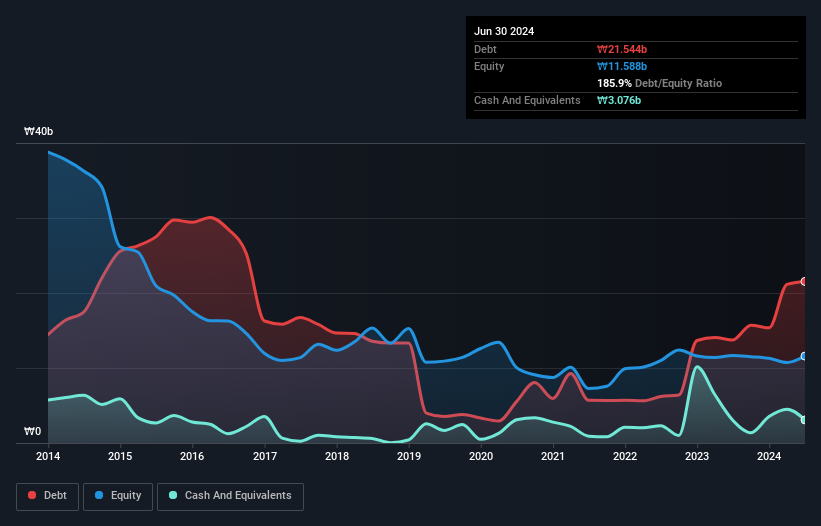
David Iben put it well when he said, 'Volatility is not a risk we care about. What we care about is avoiding the permanent loss of capital.' It's only natural to consider a company's balance sheet when you examine how risky it is, since debt is often involved when a business collapses. As with many other companies CNPLUS Co., Ltd. (KOSDAQ:115530) makes use of debt. But should shareholders be worried about its use of debt?
When Is Debt Dangerous?
Debt is a tool to help businesses grow, but if a business is incapable of paying off its lenders, then it exists at their mercy. Ultimately, if the company can't fulfill its legal obligations to repay debt, shareholders could walk away with nothing. However, a more frequent (but still costly) occurrence is where a company must issue shares at bargain-basement prices, permanently diluting shareholders, just to shore up its balance sheet. Of course, the upside of debt is that it often represents cheap capital, especially when it replaces dilution in a company with the ability to reinvest at high rates of return. When we think about a company's use of debt, we first look at cash and debt together.
Check out our latest analysis for CNPLUS
What Is CNPLUS's Net Debt?
As you can see below, at the end of June 2024, CNPLUS had ₩21.5b of debt, up from ₩13.7b a year ago. Click the image for more detail. However, it also had ₩3.08b in cash, and so its net debt is ₩18.5b.

How Healthy Is CNPLUS' Balance Sheet?
According to the last reported balance sheet, CNPLUS had liabilities of ₩27.2b due within 12 months, and liabilities of ₩8.81b due beyond 12 months. On the other hand, it had cash of ₩3.08b and ₩11.3b worth of receivables due within a year. So it has liabilities totalling ₩21.6b more than its cash and near-term receivables, combined.
This is a mountain of leverage relative to its market capitalization of ₩33.5b. Should its lenders demand that it shore up the balance sheet, shareholders would likely face severe dilution.
We use two main ratios to inform us about debt levels relative to earnings. The first is net debt divided by earnings before interest, tax, depreciation, and amortization (EBITDA), while the second is how many times its earnings before interest and tax (EBIT) covers its interest expense (or its interest cover, for short). This way, we consider both the absolute quantum of the debt, as well as the interest rates paid on it.
CNPLUS shareholders face the double whammy of a high net debt to EBITDA ratio (6.9), and fairly weak interest coverage, since EBIT is just 0.63 times the interest expense. The debt burden here is substantial. Investors should also be troubled by the fact that CNPLUS saw its EBIT drop by 17% over the last twelve months. If things keep going like that, handling the debt will about as easy as bundling an angry house cat into its travel box. When analysing debt levels, the balance sheet is the obvious place to start. But you can't view debt in total isolation; since CNPLUS will need earnings to service that debt. So when considering debt, it's definitely worth looking at the earnings trend. Click here for an interactive snapshot.
Finally, while the tax-man may adore accounting profits, lenders only accept cold hard cash. So we always check how much of that EBIT is translated into free cash flow. During the last three years, CNPLUS burned a lot of cash. While that may be a result of expenditure for growth, it does make the debt far more risky.
Our View
To be frank both CNPLUS's interest cover and its track record of converting EBIT to free cash flow make us rather uncomfortable with its debt levels. And even its EBIT growth rate fails to inspire much confidence. After considering the datapoints discussed, we think CNPLUS has too much debt. That sort of riskiness is ok for some, but it certainly doesn't float our boat. The balance sheet is clearly the area to focus on when you are analysing debt. However, not all investment risk resides within the balance sheet - far from it. We've identified 5 warning signs with CNPLUS (at least 2 which are significant) , and understanding them should be part of your investment process.
At the end of the day, it's often better to focus on companies that are free from net debt. You can access our special list of such companies (all with a track record of profit growth). It's free.
New: AI Stock Screener & Alerts
Our new AI Stock Screener scans the market every day to uncover opportunities.
• Dividend Powerhouses (3%+ Yield)
• Undervalued Small Caps with Insider Buying
• High growth Tech and AI Companies
Or build your own from over 50 metrics.
Have feedback on this article? Concerned about the content? Get in touch with us directly. Alternatively, email editorial-team (at) simplywallst.com.
This article by Simply Wall St is general in nature. We provide commentary based on historical data and analyst forecasts only using an unbiased methodology and our articles are not intended to be financial advice. It does not constitute a recommendation to buy or sell any stock, and does not take account of your objectives, or your financial situation. We aim to bring you long-term focused analysis driven by fundamental data. Note that our analysis may not factor in the latest price-sensitive company announcements or qualitative material. Simply Wall St has no position in any stocks mentioned.
About KOSDAQ:A115530
Good value with imperfect balance sheet.
Market Insights
Community Narratives



